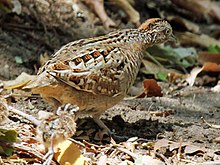Black throated chicken
| Black throated chicken | ||||||||||
|---|---|---|---|---|---|---|---|---|---|---|

Black-throated chicken ( Turnix nigricollis ) |
||||||||||
| Systematics | ||||||||||
|
||||||||||
| Scientific name | ||||||||||
| Turnix nigricollis | ||||||||||
| ( Gmelin , 1789) |
The Black-throated Laufhühnchen ( Turnix nigricollis ) is on some islands in the Indian Ocean occurring bird from the family of Laufhühnchen (Turnicidae). The specific epithet is based on the Latin words nigro for 'black' and collum for 'neck'.
features
Black-throated chicken reach a body length of 13 to 16 centimeters and a weight of 70 to 72 grams for the males and 59 to 84 grams for the females. They resemble a quail ( Coturnix coturnix ) in their appearance . The body is rounded, the neck short. There is a clear sexual dimorphism between the sexes in terms of plumage color . The females have black throats and orange-brown shoulder feathers. These two characteristics are absent in the males. The rest of the plumage is similar in both sexes. On the middle of the head and on the sides of the crown, the shaft lines of the feathers form a total of five white vertical stripes. A white longitudinal drawing made up of lines from the shaft stands out from the dark brown back. The gray-brown wing-coverts and wing feathers are provided with a pattern formed from red-brown and whitish stripes. The chest and stomach are light gray, the legs and feet are white-gray. The beak is colored blue-gray.
distribution and habitat
The black-throated chicken is found on some islands in the Indian Ocean, including Madagascar with surrounding small islands, Réunion and Juan de Nova . It was introduced in Mauritius , but was unable to form stable populations there and has now disappeared again. The main habitat are open grasslands, savannahs , dry sparse forests and sugar cane plantations . The altitude distribution ranges from sea level to a maximum of 2000 meters.
Way of life
The birds feed on seeds and insects. Food is sought by scratching the ground with their feet, and they appear in pairs or in groups of up to twelve animals. The breeding season in Madagascar falls from August to February, on Réunion, breeding activities have been observed all year round. The couples live monogamous . The nest is created by both sexes in a shallow hollow on the ground, has an inner diameter of approx. Seven centimeters, is often provided with a small roof and equipped with three to five whitish or reddish and brown, black or red speckled eggs, which from the Males can be hatched in 13 to 16 days. Abandoned nests are destroyed by the female. The chicks flee the nest , stay with their parents for about four weeks and are then independent.
Danger
The black-throated hare is widespread in its range and occasionally follows into cultivated areas. Although the species is hunted in Madagascar, it is considered stable and is therefore classified as ![]() “ least concern” by the World Conservation Organization IUCN .
“ least concern” by the World Conservation Organization IUCN .
Individual evidence
- ↑ a b c d S. Debus & GM Kirwan (2017). Madagascar Buttonquail (Turnix nigricollis). In: J. del Hoyo, A. Elliott, J. Sargatal, DA Christie & E. de Juana (eds.). Handbook of the Birds of the World Alive. Lynx Edicions, Barcelona. (viewed at http://www.hbw.com/node/53540 on April 4, 2017).
- ↑ occurrence
- ^ IUCN Red List
literature
- Josep del Hoyo , Andrew Elliott, Jordi Sargatal : Handbook of the Birds of the World, Mousebirds to Hornbills. Volume 3, Lynx Edicions, 1996, ISBN 978-84-87334-20-7 .
Web links
- worldbirdnames - IOC World Bird List
- Black-throated chicken (Turnix nigricollis) in the Encyclopedia of Life . Retrieved August 11, 2017.

